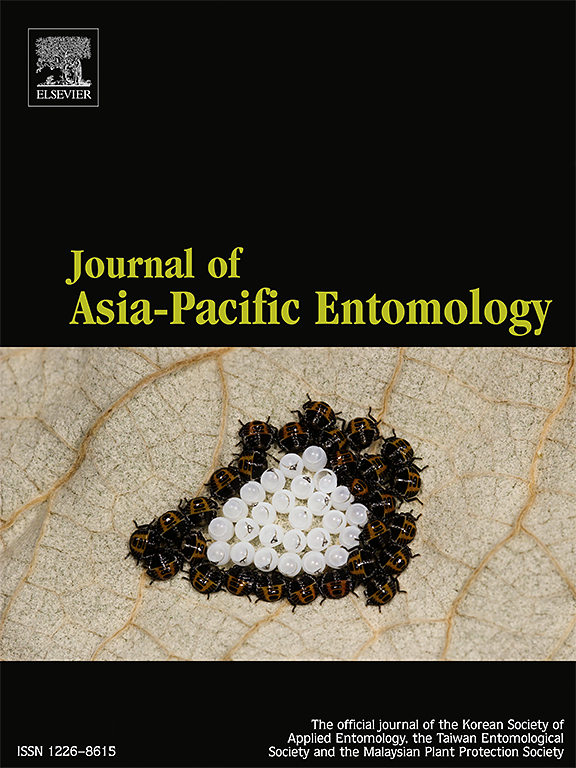基于线粒体和微卫星数据的夏威夷蓟马(Thysanoptera: Thripidae)宿主相关遗传分析
IF 1.1
3区 农林科学
Q3 ENTOMOLOGY
引用次数: 0
摘要
夏威夷Thrips (Morgan, 1913)(蓟翅目,蓟科)是中国农作物和园艺植物的常见害虫。然而,夏威夷舌蝗的种群进化史和遗传变异性尚不清楚。本研究利用线粒体细胞色素氧化酶亚基I (COI)基因和6个微卫星位点,对来自两个地区13种寄主植物的夏威夷T. hawiensis的遗传多样性和结构进行了分析。从13个开花寄主的123个个体中鉴定出23个单倍型,并通过COI序列和微卫星数据证实了夏威夷T. hawiensis的高遗传多样性。单倍型分析表明夏威夷白舌蝗种群存在两个聚类,贝叶斯聚类分析和PCoA分析也支持这一结果。遗传分化系数(Fst)和基因流(Nm)表明,不同寄主的夏威夷金翅虫基因分化较弱,基因流较高。这可以通过人类活动来促进,特别是地理距离最近的CL和GYZYMRJ。人口统计学分析结果表明,不同寄主植物的夏威夷斑蝽遗传结构差异不明显,遗传变化可能与农药胁迫有关。分析了夏威夷田鼠的入侵历史和人类活动对当前单倍型寄主分布的可能影响。本文章由计算机程序翻译,如有差异,请以英文原文为准。

Host-associated genetic analysis of Thrips hawaiiensis (Thysanoptera: Thripidae), inferred from mitochondrial and microsatellite data
Thrips hawaiiensis (Morgan, 1913) (Thysanoptera, Thripidae), a frequent pest in crops and horticultural plants, is widely distributed in China. However, the population evolutionary history and genetic variability of T. hawaiiensis is unknown. In the current study, the genetic diversity and structure of T. hawaiiensis from thirteen host plants in two regions were detected using mitochondrial cytochrome oxidase subunit I (COI) gene and six microsatellite loci. From 123 individuals collected from thirteen flowering hosts, 23 haplotypes were identified, and the high genetic diversity of T. hawaiiensis was demonstrated by COI sequence and microsatellite data. Haplotype analysis indicated two clusters of T. hawaiiensis populations, Bayesian clustering analysis and PCoA analysis also supported this result. The genetic differentiation coefficient (Fst) and gene flow (Nm) showed weak gene differentiation and relatively high gene flow in T. hawaiiensis from different hosts. This might be facilitated through human activities, especially CL and GYZYMRJ with the closest geographical distance. The results of demographic analysis suggested that the differences in genetic structure of T. hawaiiensis from different host plants are not obvious, and genetic changes may be related to pesticide stres. The possible influences of T. hawaiiensis invasion history and human activities on the current haplotype host distribution were interpreted.
求助全文
通过发布文献求助,成功后即可免费获取论文全文。
去求助
来源期刊

Journal of Asia-pacific Entomology
Agricultural and Biological Sciences-Insect Science
CiteScore
2.70
自引率
6.70%
发文量
152
审稿时长
69 days
期刊介绍:
The journal publishes original research papers, review articles and short communications in the basic and applied area concerning insects, mites or other arthropods and nematodes of economic importance in agriculture, forestry, industry, human and animal health, and natural resource and environment management, and is the official journal of the Korean Society of Applied Entomology and the Taiwan Entomological Society.
 求助内容:
求助内容: 应助结果提醒方式:
应助结果提醒方式:


